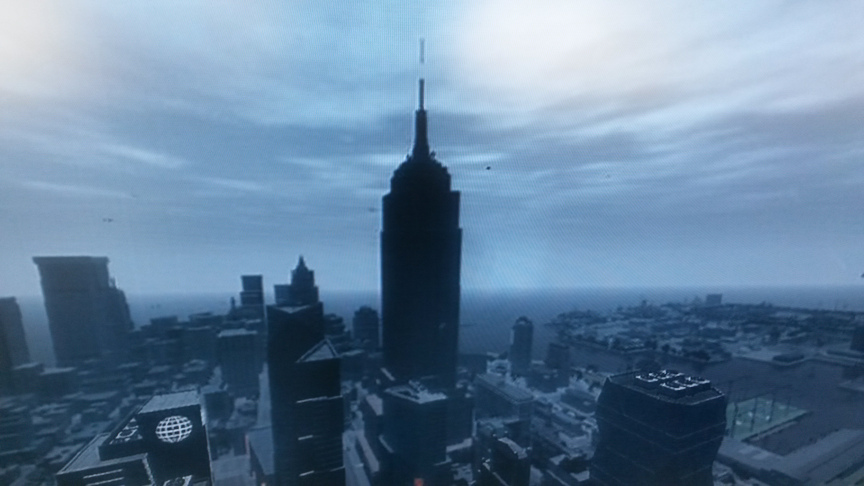IN A NEW INSTALLMENT OF OUR ONGOING SERIES ON SLOW MACHINIMA, WE DISCUSS THE PHENOMENOLOGY OF "MEANINGFUL BOREDOM".
“In Zen they say: If something is boring after two minutes, try it for four. If still boring, try it eight, sixteen, thirty-two, and so on. Eventually one discovers that it’s not boring at all but very interesting.” (John Cage)
“I like boring things.” (Andy Warhol)
In my last two posts, I wrote about the aesthetics of slow machinima, that is a certain formal trend in contemporary machinima can be seen as an act of cultural resistance to speed and acceleration. In the last few years, several authors have challenged the frantic pace of modern video games - and visual culture in general - by creating machinima that are spectacularly uneventful, often lengthy and glacially paced. I argued that slow machinima is the videogame equivalent of slow cinema, an expression indicating modern feature-length films that carry on the legacy of arthouse auteurs like Michelangelo Antonioni and Chantal Akerman by offering minimal action, narrative development, and movement, often borrowing the aesthetics of photography and painting. If “static films offer radical challenges to conventional conceptions of cinema, since they are ostensibly motion pictures without motion”, writes Justin Remes, static machinima are even more radical. If motion is essential to cinema in the same way that interactivity is crucial to the medium of video games, removing both interactivity and motion from a video game creates a visual artifact twice as removed from its “source”.
Interestingly, most static machinima are not completely static. Even in the case of Philip Solomon’s EMPIRE - in which a fixed shot of the Rotterdam Tower (a replica of the Empire State Building) in a virtual city reminiscent of New York dominates the frame for more than forty eight minutes - and much longer in other cases (1) - things do happen, constantly. In other words, although stasis is foregrounded, the scene does change in the background. Although motion and movement are toned down, they are not completely eradicated from the frame. Nonetheless, slow & static machinima blur the line between the visual arts and gaming, film and video art. It could be argued that Douglas Gordon’s 24 Hour Psycho is to Alfred Hitchcock’s Psycho what slow/static machinima (Solomon's EMPIRE) is to the original video game (Grand Theft Auto IV).
After briefly sketching the aesthetics of slow machinima in my previous posts, I now wish to discuss a few phenomenological aspects. I am especially interested in the forms of spectatorship of these kinds of productions. Every time I screen slow/static machinima, I notice two kinds of reaction from the audience. One faction finds the images absorbing, mesmerizing, even hypnotic. A second group rejects them as boring, tedious, even excruciating. In the former, watching often leads to an epiphany: after a few minutes of confusion, bedazzlement, and surprise, the spectator develops a peculiar fascination for the work on display. This viewing position is akin to a religious experience, one in which the aura of the work of art manifests itself in its formal majesty. This aura, as Remes suggests, is often nothing else than the witnessing of time itself, an overpowering perception of what it is normally ignored, repressed, or distanced, i.e. consciousness itself.
A more common reaction consists in frustration, rejection, and stubborn resistance. The average spectator who equates video games to an interactive equivalent of what film critic Tom Gunning (2000) (via Sergei Eisenstein, 1998) has called “the cinema of attractions” is at loss when confronted with a video that looks like a game, but behaves like something else, a bizarre hybrid of a painting, photograph, and video installation. Slow/static machinima is usually dismissed as an experiment in boredom, or, worse, as a prank inflicted upon unsuspecting viewers.
I believe there is a third way between veneration and rejection. Remes’ definition of “furniture films” aptly describes a mode of consumption situated halfway between the two dominant viewing positions. If veneration presupposes a deep attention and rejection implies complete distraction, one can imagine the cinematic equivalent of what Linda Stone (1998) called “continuous partial attention” (CPA), i.e. the process of paying simultaneous attention to a number of sources of incoming information, but at a superficial level. According to Stone, this fragmentary viewing experience is now prevalent in our culture. Similarly, Katherine Hayles (2007) distinguishes between “deep attention” and “hyper attention”. She writes:
Deep attention, the cognitive style traditionally associated with the humanities, is characterized by concentrating on a single object for long periods (say, a novel by Dickens), ignoring outside stimuli while so engaged, preferring a single information stream, and having a high tolerance for long focus times. Hyper attention is characterized by switching focus rapidly among different tasks, preferring multiple information streams, seeking a high level of stimulation, and having a low tolerance for boredom.
Remes calls Andy Warhol’s Empire the quintessential “furniture film”, that is, a cinematic work specifically designed to be viewed partially, distractedly. He writes:
By repudiating movement, Warhol creates films that do not demand close attention, so these works can be enjoyed in conjunction with other activities, such as conversing, eating, drinking, and dancing.
...Or texting, skimming photos and posts on a smartphone etc.
Remes suggests that Warhol's cinematic production can be compared to Erik Satie's musical inventions. Among other things, Satie invented the genre of furniture music (musique d’ameublement), i.e. music that does not require full attention, but becomes a kind of a spatial soundtrack, an aural background. A perfect example is his composition Vexations (1893).
Vexations consists of a short theme in the bass whose four presentations are heard alternatingly unaccompanied and played with chords above. According to Satie, "In order to play the theme 840 times in succession, it would be advisable to prepare oneself beforehand, and in the deepest silence, by serious immobilities". Vexations introduced a radical new way of listening to music. Likewise, Remes writes that films like Empire and Sleep “open up new ways of thinking about cinematic reception by inviting a series of distracted glances rather than a focused and comprehensive gaze.”
In a work like Brent Watanabe’s San Andreas Deer Cam (2016), an AI controlled deer wanders through the city, causing havoc. Its actions are streamed live, 24/7, on an internet website set up by Watanabe himself. There are not narrative imperatives: the continuous, real-time streaming of random situations can hardly be called a “story”, therefore an inattentive viewer could not possibly miss a turning point, a significant twist, a resolution or a cliffhanger because these narrative techniques are completely absent. San Andreas Deer Cam is an example of furniture machinima not because it is slow, boring, and/or uneventful per se, but because the events, situations, and accidents it depicts do not create an intelligible, self-contained, and ultimately coherent narrative. When something exceeds the viewing resources of a spectator - both in on temporal and cognitive levels - it becomes pure noise. It becomes a piece of furniture. In this case, a piece of generative furniture, one that favors randomness to repetition. How can a work like San Andreas Deer Cam be approached? Describing Sleep in a 1963 interview, Warhol said “It’s a movie where you can come in at any time. And you can walk around and dance and sing…. It just starts, you know, like when people call up and say ‘What time does the movie start?’ you can just say ‘Any time.’ (quoted in Remes). The same applies to a machinima that can be looked at but not fully seen. Watanabe provides the viewer with an open window on an urban environment where a computer-controlled animal runs free. When it comes to watching San Andreas Deer Cam, there are no expectations, requirements or demands. The ideal set up of Watanabe's work would be a gallery space or a projection room where visitors come and go, constantly. San Andreas Deer Cam cannot be watched, but only experienced.
Ashley Blackman, Freedom, HD Video, sound, color, 2016, 4' 48"
Ashley Blackman - a second year student at Falmouth University in the United Kingdom - turns his camera to the sky to film the glacial movement of clouds for almost ten minutes. The fact that this visual record is produced within the post-apocalyptic world of Fallout 4 makes this gesture of radical simplicity even more interesting. Blackman’s Clouds (2016) is significant not only because it perfectly exemplifies the contemplative, ruminative approach of slow machinima, but also because it engages in a conversation with several other video works, from Cory Arcangel’s Super Mario Clouds (2002) to Harun Farocki’s Parallel I (2012), not to mention conceptual pieces by the likes of Sol LeWitt.
Harun Farocki, Parallel I, 2012
The same could be said of another recent piece by Blackman, Freedom (2016), which is, simultaneously, a machinimic depiction of an American flag shot by a fixed camera and a homage to Jasper John’s seminal painting, produced between 1954 and 1955. The strength of Blackman's machinima lies in its stark simplicity and minimalism. Similarly to Watanabe’s San Andreas Deer Cam, Freedom can be accessed and abandoned at will. There is no clear beginning or definite end. Just flux. The viewing experience can coincide to the full duration of the work or be limited to a few minutes, even seconds. It can be devotional or partial, deep or hyper. One may wonder if such definitions as furniture machinima and its antithesis (immersive, video art) rely on intrinsic features of the work or rather on the specific attitude of the viewer. A viewer might find Clouds or Flag overwhelming in their utter banality while another could appreciate its bold originality and/or the artist's unconventional gesture. As Remes notes in discussing the possible reception of a slow, static film,
The goal is not to prescribe a certain mode of spectatorship but merely to draw attention to a dimension of static films (and of cinema more broadly) that is often overlooked: the way viewers can derive pleasure from components of a cinematic experience that have little to do with the film itself.
If we substitute the term “film” with “machinima”, the meaning of this statement does not change. As Remes concludes, “Warhol’s static films are interesting precisely because they are boring. Or, to put it another way, the content of Warhol’s films is often boring, but this is what makes the experience of watching them so potentially interesting.” Discussing the aesthetics of Tree Movie by Marc Low, June Nam Paik used the expression “meaningful boredom” (quoted in Friedman, 2009). Slow machinima, a hybrid form intersecting both experimental film, avant-garde practices, and video art, is deeply meaningful because it is often deliberately boring.
Matteo Bittanti
NOTES
(1) In 2008, Solomon's EMPIRE has been screened for 127 hours consecutively at the Wexner Center for the Arts.





